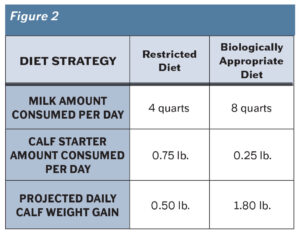Click here to view as a pdf: Biologically Appropriate Calf Feeding
The performance and production ability of a cow are determined by the quality of nutrition and health management they receive as a calf. Since calf raising is expensive, it is important to determine the most efficient and effective feeding method available. Calves are biologically designed to thrive on milk for the first portion of their life and are able to gain weight very efficiently during this time. Feeding increased levels of milk, or milk replacer can be the best way to increase calf growth rates early in life.
Feeding adequate calories from milk helps achieve growth rates of 1.7 to 2 lb. per calf per day. These are the growth rates needed to double the birth weight at weaning, which should be a performance goal for all calf raisers. Achieving these rates is an expensive process, and because of that, producers may look for cheaper ways to raise calves by weaning early (less than 56 days), feeding decreased quantities of milk or milk replacer, and/or trying to drive calves on to an inexpensive calf grain starter within just a few days of life. Accelerated milk feeding, with enough days on milk and moderate intake of a properly formulated calf starter, can be key to maximizing calf growth, health, and setting the stage for a productive life as a cow upon entering the milking herd.
Milk for Early Weight Gain
Calves are not functioning ruminants at birth. For roughly the first two weeks of life, calves are essentially monogastric animals. During this time, the abomasum is the one functional compartment of the calf’s stomach, being efficient at digesting nutrients from milk or milk replacer. While the calf’s rumen and digestive system develops, they are slow to consume grain and do not absorb nutrients from starches and vegetable proteins easily. Figure 1 outlines the number of calories provided to calves with the correlated different rates of gain. These numbers are based on a 100 lb. Holstein calf that is under normal thermoneutral conditions (meaning there were no additional energy needs to account for due to heat or cold stress). Whole milk contains roughly 2,400 calories per gallon. Milk replacer powder provides calves around 2,200 calories per gallon. Figure 1 shows that calves need to be provided a minimum of 2 gallons of milk or milk replacer daily to achieve biologically possible growth rates that near 2 lb. of weight gain per day.
Figure 2 illustrates two different calf-feeding scenarios: a restricted diet and a biologically appropriate diet. Both diets were entered in the calf model of the Nutritional Dynamic System (NDS) Ration Modeling Software which predicts calf growth performance. With the restricted diet, calves are being fed one gallon of milk per day (two quarts per feeding, twice a day). Even with a calf starter intake of up to 0.75 lb./hd./day at as early as 10 days of age, the calves in the restricted group are only estimated to gain 0.5 lb. per day.
In the biologically appropriate diet, calves are consuming 2 gallons of milk per day (four quarts per feeding, twice a day) and driving onto grain a bit slower, eating only 0.25 lb./hd./day. The increased milk intake, even with a lower starter intake, yields greater target weight gains of 1.8 lb./hd./day for these calves.
Calves show that receiving increased milk quantities early in life is the most biologically appropriate feeding strategy that reflects their natural behavior. Calves have a natural ambition to drink large quantities of milk. In one study, the behaviors and performance of two groups of calves were compared. One group received milk fed to 10% of their body weight (roughly one gallon per day) and one group was able to drink milk ad libitum. The ad libitum-fed group of calves drank 89% more milk than the control-fed calves during the pre-wean period. This increase in milk intake produced a 63% increase in weight gain compared to the control group. The ad libitum calves also only ate 16% as much starter feed and 17% as much hay as the limit-fed group. This difference in starter and hay consumption evened out very quickly between the groups after weaning and no post-weaning weight gain difference was seen. This allowed the ad libitum calves to maintain their growth advantage through the post-wean period. Studies like this prove that given the opportunity, calves can and will consume large quantities of milk resulting in effective weight gains early in life.
A Different Take on Calf Grain
While calves gain weight very well on milk, they do need to transition onto dry feed to achieve rumen development. While some sources recommend encouraging calves on to starter around day three, Crystal Creek® advises waiting until between two to three weeks of age. At this point, the calf is much more capable of producing the digestive enzymes needed to break down the starches, fiber, and sugars in calf grain. These fermentable carbohydrates in calf starter are what promote volatile fatty acid formation in the rumen of the calf. These volatile fatty acids, especially butyric and propionic acid, stimulate ruminal papillae growth. The formulation of the calf starter plays a very important role in intake levels and calf performance. We often think about acidosis in mature cows, but rarely is it talked about with young calves. Many starters rely heavily on corn starch in processed forms to increase energy levels in the starter. These fine-ground, fully pelleted, or steam-flaked corn-based calf starters oftentimes contain very fermentable starch that makes up 35-45% of the feeds dry matter. This can be a recipe for digestive issues and acidosis in young calves with developing rumens. Crystal Creek® takes a different approach to calf starter, again focusing on a biologically appropriate formula. Crystal Creek® utilizes texturized calf feeds with coarse cracked or whole grains and low to moderate starch levels. This unique formulation with high levels of very digestible neutral detergent fiber (NDF) provides energy to the calf with more fiber and less starch, lessening the risk for acidosis and increasing starter intake. This increased starter intake aimed at fiber digestion helps to smooth the transition of weaning and promotes feed and forage intake after weaning.
It is important to remember that water not only plays a role in hydration and supporting basic bodily functions, but it also drives calf starter/ feed intake which in turn will help promote rumen development. Calves should have access to a fresh, clean water supply, especially during extreme heat and extreme cold weather temperatures.
Calves are the future of the dairy herd. The nutrition and care calves receive during their first two years of life will directly impact their performance when entering the milking herd. Calves fed with higher levels of milk or milk replacer and a properly formulated calf starter will gain weight more rapidly and achieve better rumen development. Healthy calves grow to be productive cows that improve the profitability of a dairy. To learn more about how Crystal Creek® can help your calves with a biologically appropriate calf-raising program, call 1-888-376-6777 and ask to speak to one of our knowledgeable representatives.
References available upon request.


